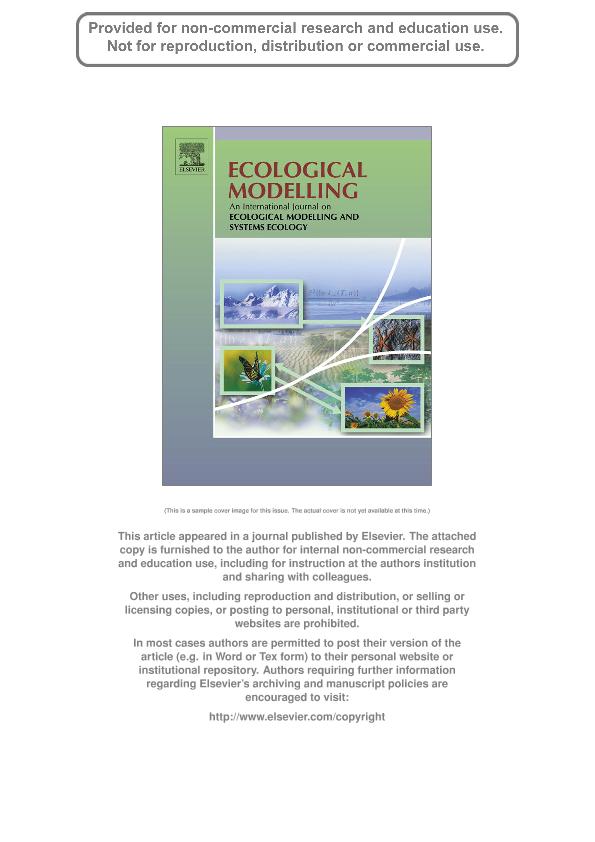Mostrar el registro sencillo del ítem
dc.contributor.author
Caceres Garcia Faure, Manuel Osvaldo

dc.contributor.author
Cáceres Saez, Iris

dc.date.available
2015-10-30T19:48:08Z
dc.date.issued
2013-02-21
dc.identifier.citation
Caceres Garcia Faure, Manuel Osvaldo; Cáceres Saez, Iris; Calculating effective growth rate from a random Leslie model: Application to incidental mortality analysis; Elsevier Science; Ecological Modelling; 251; 21-2-2013; 312-322
dc.identifier.issn
0304-3800
dc.identifier.uri
http://hdl.handle.net/11336/2591
dc.description.abstract
Demographic models are commonly used to study cetacean population dynamics and are characterized by a wide range of age classes. The primary building blocks are age-specific survival or mortality and birth rates, which can be combined using a Leslie matrix protocol to provide estimates of maximum possible rates of increase for population size. In this context, specific mortality data are valuable for modeling the viability of threatened species. Depletion of prey, pollution, and other anthropogenic disturbances are believed to have contributed to the decline of populations, but the evidence is less conclusive for these factors than for bycatch. In an attempt to estimate a population growth rate that incorporates uncertainties in vital parameters, we apply a random Leslie analysis to calculate effective growth rate for the time-dependent mean-value population. Here we provide the algorithm to implement it for a general 13×13 random survival model. An effective growth rate can be characterized by studying the time evolution of the mean-value population vector state (in an age-structured description). We show that the asymptotic behavior of the mean-value vector state, which characterizes the population growth rate when the model has random vital parameters, exhibits a value that is below previously expected potential estimations. We demonstrate the procedure using bibliographic revision data of the harbor porpoise (Phocoena phocoena) in Canadian waters, subjected to incidental mortality.<br />
dc.format
application/pdf
dc.language.iso
eng
dc.publisher
Elsevier Science

dc.rights
info:eu-repo/semantics/openAccess
dc.rights.uri
https://creativecommons.org/licenses/by-nc-sa/2.5/ar/
dc.subject
Random Leslie Matrix
dc.subject
Effective Growth Rate
dc.subject
Uncertainty
dc.subject
Cetacean Population Dynamics
dc.subject
Harbor Porpoise
dc.subject.classification
Biofísica

dc.subject.classification
Ciencias Biológicas

dc.subject.classification
CIENCIAS NATURALES Y EXACTAS

dc.title
Calculating effective growth rate from a random Leslie model: Application to incidental mortality analysis
dc.type
info:eu-repo/semantics/article
dc.type
info:ar-repo/semantics/artículo
dc.type
info:eu-repo/semantics/publishedVersion
dc.date.updated
2016-03-30 10:35:44.97925-03
dc.journal.volume
251
dc.journal.pagination
312-322
dc.journal.pais
Países Bajos

dc.journal.ciudad
Amsterdam
dc.description.fil
Fil: Caceres Garcia Faure, Manuel Osvaldo. Universidad Nacional de Cuyo; Argentina. Comisión Nacional de Energía Atómica. Gerencia del Area de Energía Nuclear. Instituto Balseiro; Argentina
dc.description.fil
Fil: Cáceres Saez, Iris. Consejo Nacional de Investigaciones Científicas y Técnicas. Oficina de Coordinación Administrativa Parque Centenario. Museo Argentino de Ciencias Naturales; Argentina. Universidad Nacional del Comahue. Centro Regional Universidad Bariloche; Argentina
dc.journal.title
Ecological Modelling

dc.relation.alternativeid
info:eu-repo/semantics/altIdentifier/url/http://izt.ciens.ucv.ve/ecologia/Archivos/ECO_POB%202013/ECOPO3_2013/Caceres%20y%20Caceres-Saez%202013.pdf
dc.relation.alternativeid
info:eu-repo/semantics/altIdentifier/doi/http://dx.doi.org/10.1016/j.ecolmodel.2012.12.021
dc.relation.alternativeid
info:eu-repo/semantics/altIdentifier/url/http://www.sciencedirect.com/science/article/pii/S0304380013000045
Archivos asociados
